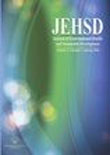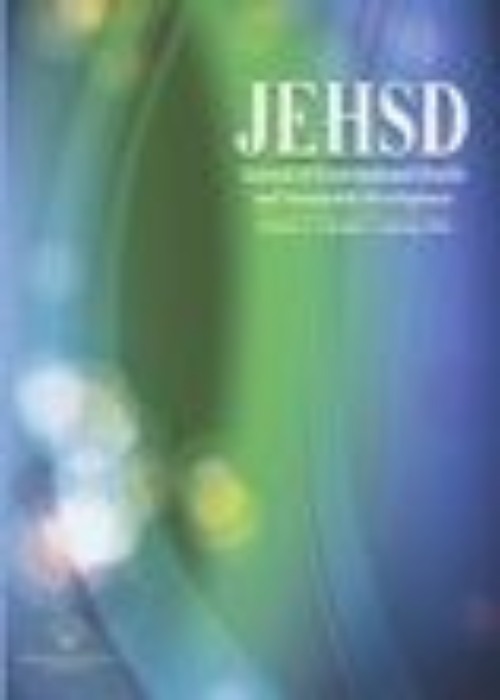فهرست مطالب

Journal of Environmental Health and Sustainable Development
Volume:2 Issue: 1, Mar 2017
- تاریخ انتشار: 1396/01/09
- تعداد عناوین: 8
-
Pages 183-191IntroductionDue to causing methemoglobinemia, different cancers, and teratogen effects in human nitrate contamination of water resources has become a critical environmental problem Therefore, the aim of this work was to determine the optimum condition of nitrate sorption onto magnetic nanoparticle.Materials And MethodsThe removal of nitrate from aqueous solutions by magnetic nanoparticle has been studied through using batch adsorption method. X-ray diffraction (XRD), Transmission Electron Microscopy (TEM), and Scanning Electron Microscopy (SEM) was applied to characterize the synthesized Fe3O4. The effect of pH, nano-magnetic, adsorbent dose, initial concentration of nitrate, and contact time were investigated.ResultsAccording to SEM and TEM images, the adsorbent particles were nanosized and spheroidal; the sizes were about 2030 nm. The experiment's results indicated that the optimum adsorbent dose was 750 mg in 1000 ml of solution, with a contact time of 90 min, while the optimum pH was 9. The kinetic models for nitrate adsorption showed rapid sorption dynamics by both first-order kinetic (R2 = 0.97) and second-order kinetic (R2=0.96) models. Nitrate adsorption equilibrium data were fitted well to the Freundlich isotherm than Langmuir isotherm.ConclusionThe results showed that, magnetic nanoparticles can be used as a low cost and efficient adsorbent for removal of nitrate from aqueous solutions.Keywords: Adsorption, Nitrate, Magnetite Nanoparticles, Kinetics
-
Pages 192-204IntroductionCleaner productions in textile industry is achieved by reducing water and chemicals consumption, saving energy, reducing production of air pollution and solid wastes, reducing toxicity and noise pollution through many solutions. The purpose of the present research was to apply Strengths, Weaknesses, Opportunities, Threats (SWOT) and Quality Systems Planning Matrix (QSPM) techniques in identifying and prioritizing production in raw materials warehouse of Yazdbaf Textile Factory.Materials And MethodsIn this research, effective internal and external factors in cleaner production were identified by providing the required information through field visit and interview with industry managers and supervisors of raw materials warehouse. Finally, To form matrix of internal and external factors 17 important internal factors and 7 important external factors were identified and selected respectively.Then, QSPM matrix was formed to determine the attractiveness and priority of the selected strategies by using results of internal and external factors and SWOT matrixes.ResultsAccording to the results, the total score of raw materials warehouse in Internal Factor Evaluation ( IFE) matrix is equal to 2.90 which shows the good situation of warehouse than the internal factors. However, the total score in External Factor Evaluation (EFE) matrix is 2.14and indicates the relative weak situation of warehouse than the external factors.ConclusionBased on the obtained results, continuity, monitor, and improvement of the general plan of qualitative control (QC) of raw materials and laboratory as well as more emphasis on quality indexes according to its importance in the production processes were selected as the most important strategies.Keywords: SWOT, Strategic planning, Cleaner production, Textile industry
-
Pages 205-216IntroductionNatural Contamination of surface and ground water with arsenic is a widespread problem around the world. The problem is of most concern where contaminated water is used for drinking purposes. Sahand is an important water reservoir in Northwest of Iran which supplies water for drinking and industrial purposes in addition to irrigation of 11000 hectares of agricultural lands.Materials And MethodsThe hydrochemistry status of Sahand dam basin and arsenic distribution were evaluated by analyzing 308 water samples from surface and ground water resources. Samples were collected based on the standard methods and some information about geological features of basin from site visiting, field investigations, and previous studies.ResultsElevated concentrations of arsenic (range=0-1440 ppb, mean=171.68 ppb) were detected in water basin and dam. According to the delineating evidences, regional geological background and volcanic activities can be considered to be the main sources of natural genesis of arsenic in water resources of the region.ConclusionA manifestation of arsenic sulfide was observed in seams, gaps, and fractures of limestone, marl, sandstone, and an ferruginous conglomerate. Concentrations of arsenic in Sahand reservoir varied seasonally; the maximum concentration of arsenic was observed in autumn and early winter (especially in December). Seasonal fluctuations can be attributed to changes in geochemical conditions of sediments at the bottom of reservoir which requires more studies.Keywords: Arsenic, Hydrology, Groundwater, Volcanic activities, Dam, Iran
-
Geo-statistical Distribution of Heavy Metals in Karoon River's Soil by Geographic Information SystemPages 217-224IntroductionSoil has an important role in nutrient cycle and an important function in storage, refinement, and movement of nutrients for the living and non-living parts. Soil pollution of heavy metals and elements is one of the common pollution impacts of human activities, especially industry. Realization of distribution pattern of these elements and their anthropogenic sources is a major part of environmental protection plans. In the present study, concentration of two major heavy metals were investigated and mapped using geostatistical methods throughout western part of Karoon river in Ahwaz city. Four land areas including urban areas, agricultural, industrial, and bare soils were applied.Materials And MethodsIn this research, at first, 40 sample plots were determined randomly from the study area and soil samples were taken from surface layer with the depth of 20 centimeters. Afterwards, the data were entered into SAS 9.3 and Arc GIS 10.2 applications for data analysis and mapping.ResultsResults showed that Pb and Cd concentrations had the lowest standard rate in western parts of city while their highest rate was in river shores, south-west, and northern parts. Hence, the soil is over polluted in these areas comparing to WHO standards.ConclusionA significant correlation was observed between Pb and Cd elements. Regarding results achieved by the semi-variance model, it is concluded that pollutions have anthropogenic sources in this area. According to the results, most important factors of pollution in this area were smelting and steel factories as well as agricultural pesticides.Keywords: Heavy Metals, soil, land statistics, kriging method, Karoon river
-
Pages 225-230IntroductionThe presence of pathogenic microbial agents and pathogens in organic fertilizers causes health problems and disease transmission.Therefore , the aim of this study was to identify bacterial and fungal species present in vermicompost production.Materials And MethodsThis experimental study was conducted in pilot scale in the laboratory of Public Health School in Shahid Sadooghi Univerity of Yazd. Sesame crust obtained from sesame pudding factory and cow manure mixed in three reactors with the dimension of 50 × 30 × 15 cm were used and went under the vermicompost process. Another reactor was also provided from cow manure as the control variable. Treatments were studied simultaneously during 60 days. Experiments were conducted to detect bacterial and fungal species.ResultsTotally 18 species of negative-gram bacterial species, i.e., Salmonella typhimurium, Salmonella Paratayfi A, Acinetobacter baumannii, Escherichia coli, Proteus mirabilis, Proteus vulgaris, Providencia alkali Fasyns, Klebsiella oxy-Toka, Ponomonya Klebsiella, Citrobacter frondii, Citrobacter Diorsus, Serratia Marsns, Hafnya Olovia, pseudomalle Burkholderia, Enterobacter Peinous, Enterobacter Anrogenious, Enterobacter de Solonos, as well as Neisseria polysakarya, and 3 positive-gram bacterial species, i.e., Bacillus subtilis, Bacillus cereus, Isteria monocytogenes grew. Overally, a total of five fungi species; Aspergillus flavus, Aspergillus niger, Cladosporium, Penicillium, yeasts, and Unknown fungal species grew.ConclusionThe results of this study showed that presence of the organism in vermicompost depends on various factors, such as the action of enzymes of gut earthworms, coelomic fluid secretion, as well as competition between different groups of microorganismsKeywords: Microbial species, Vermicompost, Sesame crust, Cow Manure
-
Pages 231-244IntroductionThe need for food produced from animal husbandry has made it a growing industry which result in increment of livestock waste. On the basis of environmental and economic considerations, these materials require treatment and management. Anaerobic digestion and creation of biogas are the most effective methods of waste management. Several parameters affect the anaerobic digestion of animal wastes which should be studied in order to optimize the biogas production of reactors.Materials And MethodsThe parameters affecting the performance of anaerobic processes in different scientific databases within 1984 -2016 were searched and related information were obtained.ResultsA wide range of reactors with retention times of 0.5 to 140 days and organic loading rates from 0.11 to 7.5 grams per liter of organic matter in a day were studied based on the Volatile Solid (VS) in different temperature range. Also, studies conducted on mixing, co-digestion, changes in pH and ammonia content of the substrate, C/N ratio, as well as the effect of chemical interference were investigated.ConclusionHigh COD removal decrement of VS were achieved in the range of 80-95 % and 65- 92 % respectively in bioreactors. The produced methane was also 48 mmol L-1 to 4681.3 m3 per month for reactors with a volume of 120 ml to 1330 m3 achieved respectively at 37 and 55˚C from the Mesophilic and thermophilic temperatures. Results summarized on the physical and chemical conditions in this paper, can be used to study the effective parameters and optimize conditions used in biogas production.Keywords: Anaerobic digestion, Biogas yield, Cattle manure, Physical, chemical parameters
-
Pages 245-254Introduction. Nickel (Ni) is one of the toxic heavy metals that exposure to it has been connected with chronic respiratory complications such as asthma, chronic bronchitis, lung cancer and heart diseases .. In this research, original studies that investigated occupational or environmental exposures to nickel and measured nickel levels in human tissues was reviewed.Materials And MethodsIn this study articles reviewed systematically. national databases such as SID and Magiran as well as some international databases including PubMed, Web of Knowledge, Scince Direct and Google Scholar were searched; to extract studies conducted in Iran until August 19, 2016.ResultsBased on the results, industrial professions such as welding and plating who dealt directly with nickel were at a higher risk of contamination. In overall, residents in large polluted cities or taking dental treatments, had more nickel concentrations in their body than others.ConclusionConsidering the high nickel contamination in industrial workers, it seems to be necessary to do regular surveillance in this group through periodic regular check-ups and avoiding unnecessary exposure to nickel as much as possible.Keywords: Nickel, Environmental exposure, Occupational exposure, Heavy metals, Iran


